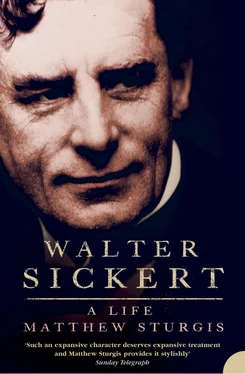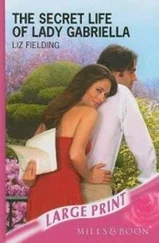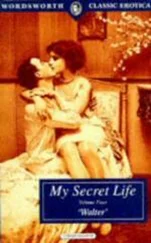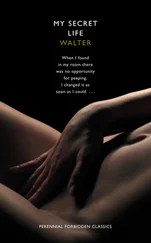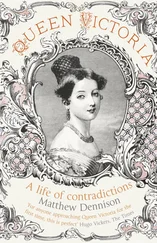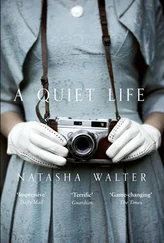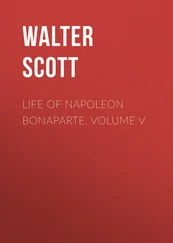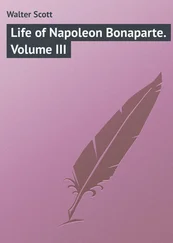The exhibition venue was an unconventional one. Sickert had been given the use of three little first-floor rooms in an old Queen Anne house at 29 Queen Square, Bloomsbury – the building was the home of the College for Working Men and Women. In this limited space he had gathered together ‘a little collection of masterpieces’: pastels, watercolours, and etchings, together with several important pictures, including the portraits of Rosa Corda, Thomas Carlyle, and the artist’s mother. From Irving, Sickert borrowed the picture of the actor as King Philip (the image that had first awakened him to Whistler’s genius). It was an impressive assemblage, as Sickert hastened to point out in the New York Herald . 36 For no very obvious reason the Lord Chancellor, Lord Halsbury, was asked to open the exhibition. * Nevertheless, despite this ploy, the show was not a success. It was unable to transcend its unpropitious setting. Press coverage was scant, and visitors rare.
Amongst the few people who did attend were two Americans recently settled in London. Joseph Pennell, then in his early thirties, had already established a reputation as an accomplished draughtsman and illustrator; his wife, Elizabeth Robins Pennell, was a prolific journalist. Together they had succeeded Shaw in writing the art criticism for The Star . They were amazed by the show, and ‘wrote urgently in the Star’ , urging everyone ‘who cared for good work … to see this exhibition of “the man who has done more to influence artists than any other modern”’. 37 It was the first blast of what would become an almost interminable fanfare over the ensuing years, as the Pennells established themselves as the jealous champions of Whistler’s name and reputation. Their championship came to have awkward consequences for Sickert’s own relationship with Whistler but, at this early stage, he was merely happy to meet two sympathetic new critics, and grateful to them for giving the show a generous puff.
If there was a sense of disappointment about the impact of the exhibition, neither Sickert nor Whistler admitted it. They continued to see each other socially. Sickert would still be invited to lunch at Whistler’s studio, especially when his favourite ‘gumbo soup’ was being served, 38 and the Whistlers dined at Broadhurst Gardens. * Nevertheless, beneath the jollity, and the offers of assistance, there remained the sense that Sickert’s attention was elsewhere. Nothing came of the plans for a catalogue of Whistler’s prints: the current of Sickert’s other interests had become too strong. On 25 May 1889, Ellen and he bought Degas’ magnificent Répétition d’un Ballet sur la Scène at Christie’s in the sale of the Henry Hill collection. It was, Sickert noted, similar in composition to the ‘monochrome’ they had seen at M. Mulbacher’s apartment. They paid only £74 for it. 39
In June, Sickert resigned his post on the New York Herald , claiming that ‘to do the work thoroughly made too great an inroad on [his] time’. 40 The respite from journalism was only temporary. Perhaps it allowed him to take a short holiday – at some point during the summer he nipped over to Paris to see his picture at the Universal Exhibition. He went round the show with Degas. It was a thrilling, and entertaining, experience. As they crossed the Jardins du Trocadéro, where countless families were picnicking on the grass, Degas observed, ‘C’est l’âge d’or en bronze!’ They studied the British section ‘with some care’. Degas enjoyed ‘mystifying people’ by making great claims for the work of very minor artists: 41 he certainly shocked Sickert by praising the handling of a waterfall painted by Frank Miles. But on the whole his comments, though barbed with wit, had a strong practical edge. He greatly admired a picture of a country christening by James Charles, but considered that it ‘would have been better on a somewhat smaller scale’. 42 Confronted by Whistler’s Lady Archibald Campbell , he remarked of the elegantly attired lady retreating into the gloom of an undefined background, ‘Elle rentre dans la cave de Watteau.’ † 43 (Whistler’s other submission – Variations in Flesh Colour and Green: The Balcony – had been awarded the Gold Medal. It was a work of 1865, and perhaps gave Sickert a sense of how long it took for new ways of seeing and painting to be understood or appreciated.) Sadly, Degas’ verdict upon Sickert’s October Sun is unrecorded.
Time spent with Degas – visiting galleries, looking at pictures, talking of art – deepened Sickert’s awe and admiration. The exceptional cohesion, or ‘purity’ as Sickert described it, of Degas’ life made a great impression. Instead of deploying his will, his talent, and his wit to make himself ‘notorious’ – as, to some extent, Whistler had done – he remained always true to his art. 44 As Sickert remarked to Blanche, shortly after returning to London, ‘I find more & more, in half a sentence that Degas has said, guidance for years of work.’ 45
Sickert’s main undertaking during the latter half of 1889 was to arrange an exhibition by the core members of the NEAC’s Impressionist clique. 46 David Croal Thomson, the young – and, as Sickert asserted, ‘fearless’ – manager of the progressive Goupil Gallery in New Bond Street, had offered them the use of his space in December. Although it was a group venture, necessitating the usual round of discussions and excited studio meetings, Sickert was, as ever, the presiding spirit and the acknowledged spokesman. 47 He helped define the limits of the group: Fred Brown, Francis Bate, Wilson Steer, Sidney Starr, Francis James, and Théodore Roussel were, of course, included; but it was probably Sickert’s influence that secured the inclusion of his brother Bernhard and George Thomson, and his indulgence that admitted Paul Maitland. 48
They chose to exhibit under the name of the ‘London Impressionists’. The title was obvious enough, perhaps even inevitable; if they had not adopted it themselves they might well have been given it by others. 49 Sickert, however, continuing the theme of his newspaper articles, worked hard to extend, if not to explode, critical preconceptions. While always admitting the eminence of Whistler and Degas, he insisted upon other perspectives and influences. When quizzed by one interviewer about what an ‘Impressionist’ was, Sickert – after some evasion – replied, ‘A definition is a terrible thing, but the meaning that we should attach to the word, if it is to stand in any way as a declaration of faith on our part, must be a very catholic one. The main article of the creed would perhaps be study and reverence for the best traditions of all time. Velasquez was an Impressionist, and Leech was an Impressionist, and Holbein was an Impressionist.’ 50
Sickert planned to exhibit three complex new music-hall paintings as well as a couple of less contentious pieces. Racing to finish his pictures for the show, he drove himself into a frenzy of activity. When Blanche came over to London in the autumn he found Sickert ‘up to [his] ears in work’. Dinner was out of the question: ‘I am tied up for the week in a picture of an obscure Music Hall in a northern suburb which necessitates my going without dinner to be in my eighteenpenny stall on the stroke of eight.’ 51 And for most of the day he was ‘full of appointments with models and serio-comics’. He could meet his friend only for a hurried lunch ‘at one o’clock (exactly)’.
As well as sketching from the ‘eighteenpenny stalls’ and having sittings from ‘serio-comics’, Sickert deployed other elements in building up his pictures. He spent time that winter working at Heatherley’s, the old-established teaching studio in Newman Street. Although he seems, in part, to have used the school merely as a convenient central London workspace, it did offer him a chance to experiment with effects of light, or semi-darkness. One young student retained ‘lively recollections’ of his visits to the ‘dingy old academy’: ‘It was a winter of much fog and consequent gaslight, and Sickert, with his then preoccupation with “atmospherics,” was in his element.’ He rarely ‘painted from the models’, but made ‘impressionist studies of figures or groups of students seen through the murk’. * 52
Читать дальше
